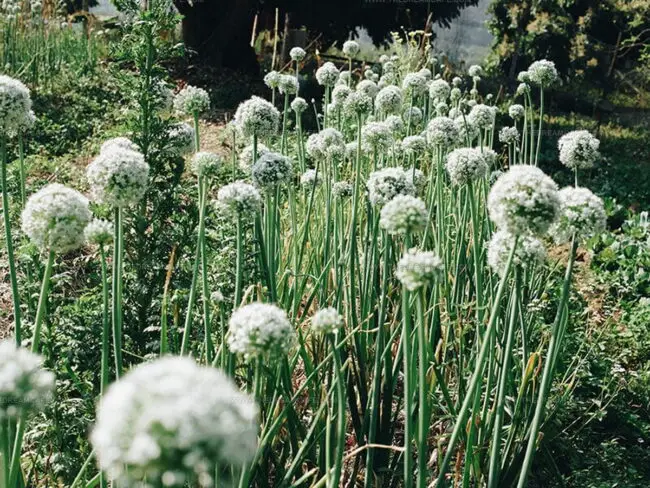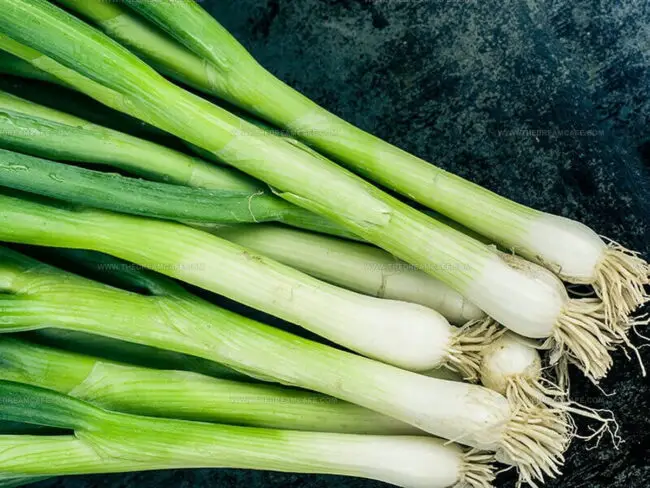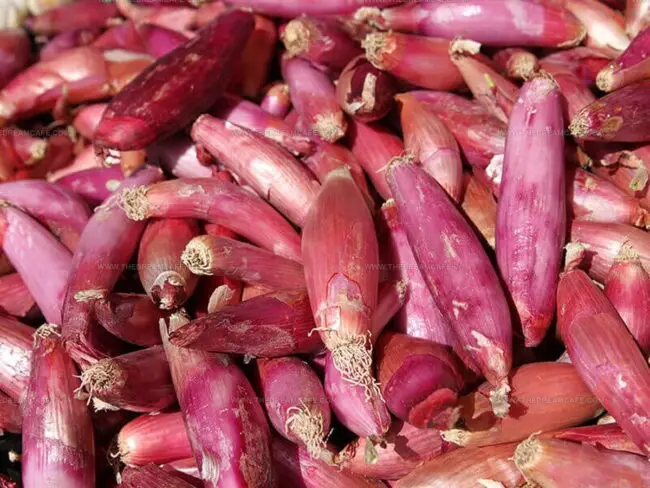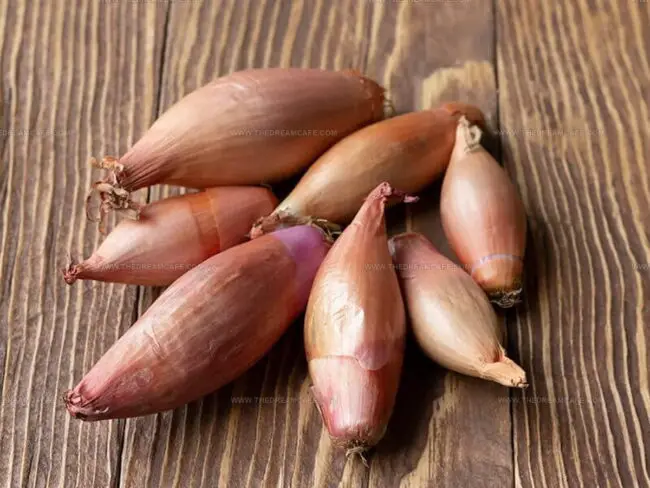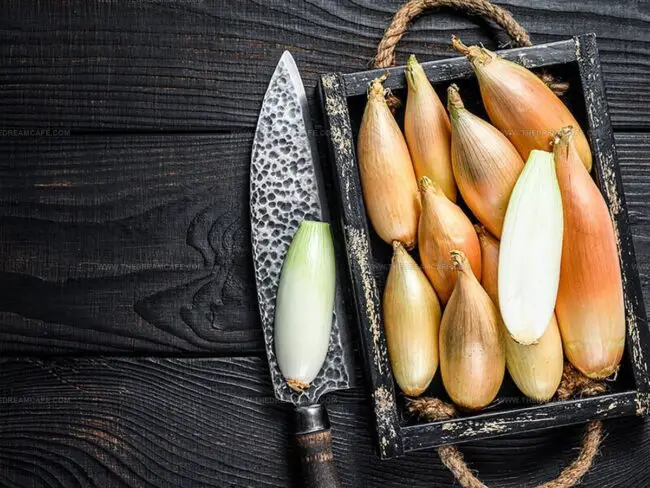Scallions or Shallots: Which Allium Reigns Supreme?
Scallions and shallots bring different flavor profiles to our favorite dishes across many cuisines.
Aromatic vegetables belong to the allium family, alongside garlic and onions.
Most home cooks have reached for scallions when making stir-fries or garnishing soups with their bright green tops.
The mild taste of scallions contrasts with shallots' more delicate, slightly garlicky character that French chefs particularly treasure.
In Asian markets, both ingredients fill produce sections, ready to enhance countless traditional recipes.
Many professional kitchens keep these versatile ingredients stocked year-round for their unique contributions to both raw and cooked applications.
Once you understand how each one works in various cooking methods, your culinary creations will take on new dimensions of flavor.
Scallions vs. Shallots – A Quick Comparison
Check this comparison table between scallions and shallots for more details.
| Category | Scallions | Shallots |
| Botanical Origin | Member of the Allium genus | Member of the Allium genus |
| Harvest Time | Harvested while still immature | Harvested at full maturity |
| Growth Pattern | Grows as individual stalks | Grows in clustered bunches |
| Appearance | Thin, long, tube-like with green tops and white stems; small root system | Small, onion-like bulbs with tapered shape; papery skin; interior has cloves |
| Flavor | Sharp, peppery, with grassy freshness from green parts; milder than shallots | Bold onion-garlic flavor with subtle sweetness; more intense than scallions |
| Health Benefits | Rich in vitamins A & C, iron, calcium; antiviral, antioxidant, antibacterial | High in potassium, phosphorus, protein; also antioxidant and antimicrobial |
| Culinary Uses | Used raw or cooked; ideal as garnish, sautéed, grilled, or roasted; common in Asian dishes | Great raw in vinaigrettes; excellent for caramelizing, roasting, pickling, or glazing; key in French cuisine |
What Are Scallions and Shallots?
Scallions and shallots share botanical roots in the Allium genus family alongside onion, leek, chives, and garlic. Both plants have similar structures with underground root and bulb systems plus overground green leaves, but their similarities largely stop there.
Farmers harvest these vegetables at completely different stages - shallots are gathered when mature with fully developed bulbs after their green parts have yellowed or fallen, while scallions are picked much earlier when leaves remain green, explaining their small, underdeveloped bulbs.
The growth pattern between these two also differs significantly; scallions grow as individual plants, whereas shallots naturally form in bunches or clusters.
Scallions vs Shallots: Spotting the Visual Differences
Scallions and shallots have such distinct looks that mixing them up becomes nearly impossible after you learn to spot the differences.
Once you've used both in your kitchen, the unique qualities of each become second nature to recognize.
Scallions
Scallions have long, thin, tube-like bodies with green tops that fade to white bottoms, and some varieties like Purplette display a purple base. Their small root system appears at the stem's base, and they grow independently without forming a clustered bulb.
These allium family members consist of circular layers that might resemble chives, spring onions, or leeks at first glance. For easy identification, remember that chives are smaller and more delicate than scallions, lacking the white stem and root.
Spring onions differ with their larger, partially-formed bulbs and tougher green sections that many people avoid eating. Leeks stand out as the largest option, sometimes reaching 1-2 inches in diameter, offering a milder taste than scallions with subtle garlic notes that diminish during cooking.
Shallots
Shallots look like tiny onions with long, pointed shapes and thin skins that peel off without much effort. They grow in small groups that resemble how garlic cloves stick together in a bunch.
The outer layer ranges from copper-pink to brown, while inside you'll find white and slightly purple flesh. Just like garlic, these little bulbs contain multiple sections that can be pulled apart or sliced through when cooking.
Taste of Scallions and Shallots
Scallions and shallots bring different tastes to your kitchen despite both being part of the allium family. These two ingredients pack quite a punch with their strong aromas, but they're far from identical when it comes to flavor profiles.
Scallion Flavor
Scallions offer a sharp, peppery flavor similar to a mix of white and yellow onions, with a fresh, grassy note from their green tops that sets them apart from other alliums. Their mild taste comes from being harvested early, making them a great choice for those who prefer a lighter, less intense onion flavor.
Scallions are ideal as a fresh-tasting alternative in dishes where subtlety is key.
Shallot Flavor
Shallots pack a stronger punch with pronounced onion and garlic tones. Despite their boldness, they still taste more refined and approachable than regular onions.
When caramelized, shallots develop a sweet, mellow richness that softens their sharpness. They pair beautifully with dishes like mashed potatoes for a simple yet flavorful upgrade.
Here are some shallot varieties:
French Gray Shallots
Also known as Allium Schaninii, French Gray Shallots are often considered “the true shallot” by culinary experts. They have a distinctive grayish outer skin with a vibrant purple interior. These shallots are prized for their strong, robust flavor, making them a favorite in gourmet cooking.
Banana Shallots
Also known as French echalion shallots, banana shallots are a hybrid that combines the mild, sweet flavor of traditional shallots with the larger size of onions. Their skins range from light pink to brown and peel easily, making them convenient to prepare. They offer a perfect balance of sweetness and volume.
Pink Shallots
Pink shallots, sometimes called Jersey shallots, are the most common commercial variety, especially in the U.S. They feature a copper-colored skin and offer the classic aromatic and flavorful qualities associated with shallots - robust yet balanced without overpowering dishes.
Yellow Shallots
Yellow shallots appeal to those who enjoy shallots but dislike the strong taste of onions. These small, golden shallots have a sweeter and lighter flavor, adding just enough onion character to enrich soups, stews, and pickled dishes. They are ideal for mellow, subtle culinary uses.
How Scallions and Shallots Boost Wellness
Scallions and shallots pack different nutritional punches despite both being fantastic for your body. Here is the nutrition table of these two.
| Nutritional Value (for 100g) | Scallions | Shallots |
| Calories | 32 kcal | 72 kcal |
| Protein | 1.83 g | 2.5 g |
| Total fat | 0.19 g | 0.1 g |
| Carbohydrate | 7.34 g | 16.8 g |
| Fiber | 2.6 g | 3.2 g |
| Sugar | 2.33 g | 7.87 g |
| Calcium | 72 mg | 37 mg |
| Iron | 1.48 mg | 1.2 mg |
| Magnesium | 20 mg | 21 mg |
| Phosphorus | 37 mg | 60 mg |
| Potassium | 276 mg | 334 mg |
| Sodium | 12 mg | 16 mg |
| Vitamin C | 18.8 mg | 8 mg |
| Vitamin B-6 | 0.061 mg | 0.345 mg |
| Vitamin A | 50 µg | 0 µg |
| Vitamin E | 0.55 mg | 0.04 mg |
| Cholesterol | 0 mg | 0 mg |
How to Cook Scallions and Shallots
Shallots and scallions bring a special taste that can really boost your cooking, and understanding how to cook them is crucial. Moreover, you can even swap them when needed, though each has its own charm in the kitchen.
Got Questions? We’ve Got Solutions
1. Can I substitute scallions for shallots in recipes?
Yes, you can substitute scallions for shallots, but the flavor will be milder and more grassy. Use only the white parts of scallions for a closer match, and you may need to use more scallions than the amount of shallots called for.
2. How should I store scallions and shallots?
Store scallions in the refrigerator wrapped in a damp paper towel or standing in a glass with a little water for up to a week. Shallots can be stored like onions in a cool, dry, dark place with good ventilation for up to a month.
3. Do scallions and shallots have different nutritional benefits?
Yes, scallions are higher in vitamins A and K, while shallots contain more antioxidants and minerals like potassium and iron. Both are low in calories and add nutritional value to your meals.
4. Which is better for raw dishes?
Scallions are generally better for raw applications like garnishes and salads because they're milder and have a fresh, crisp texture. Shallots can be used raw but have a stronger flavor that some find too pungent without cooking.

